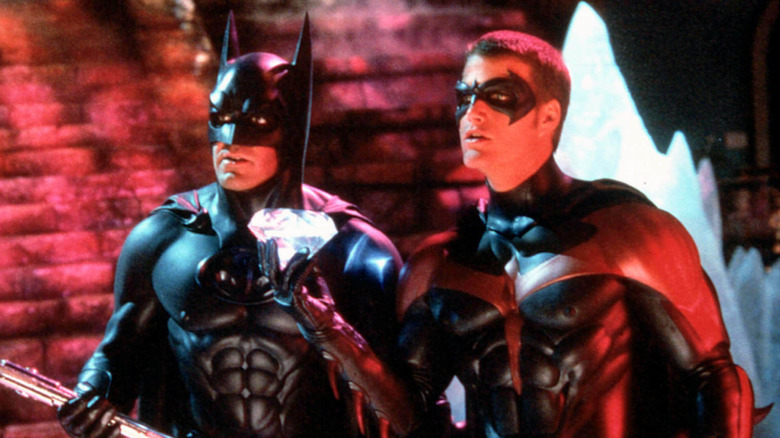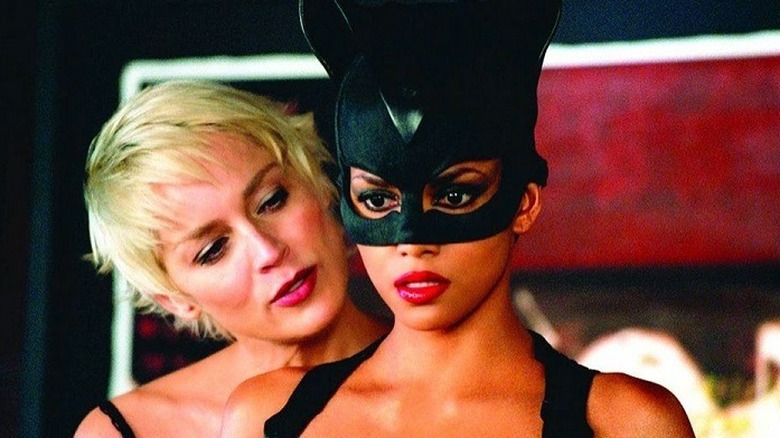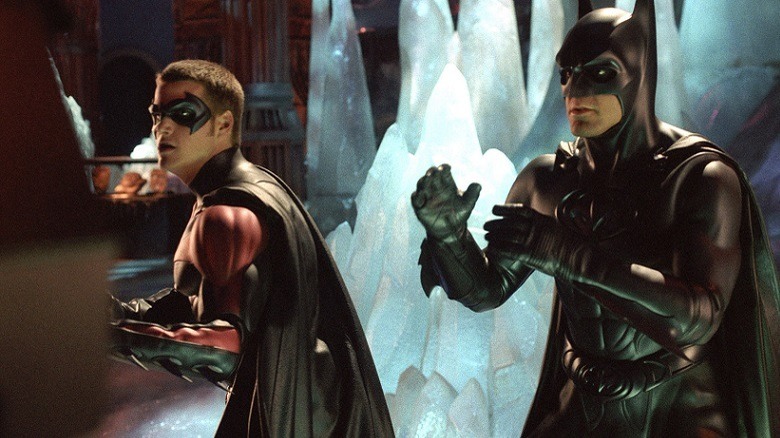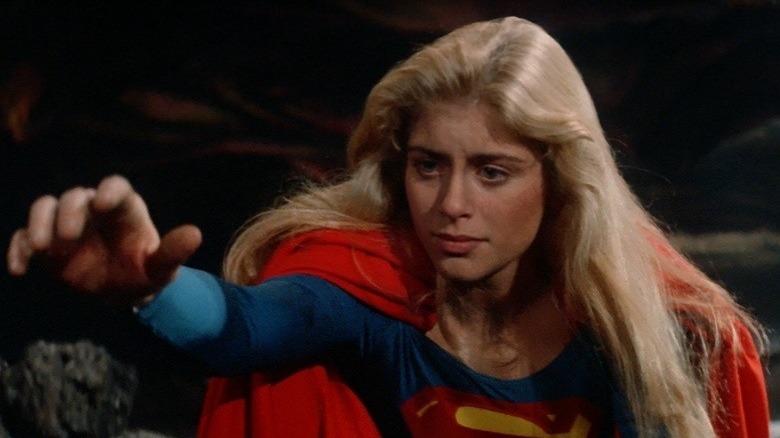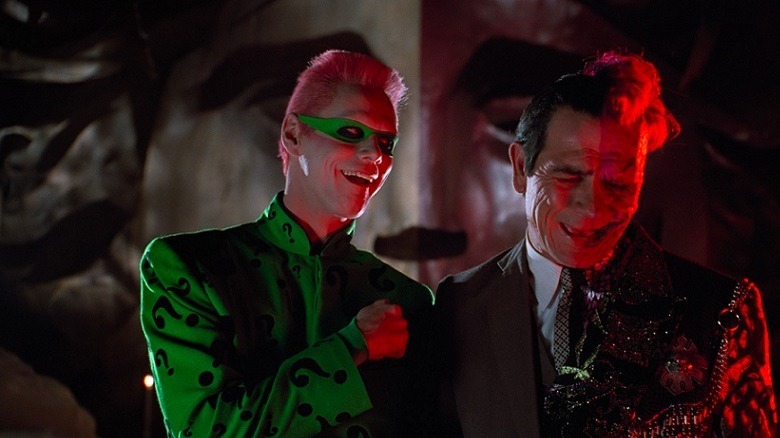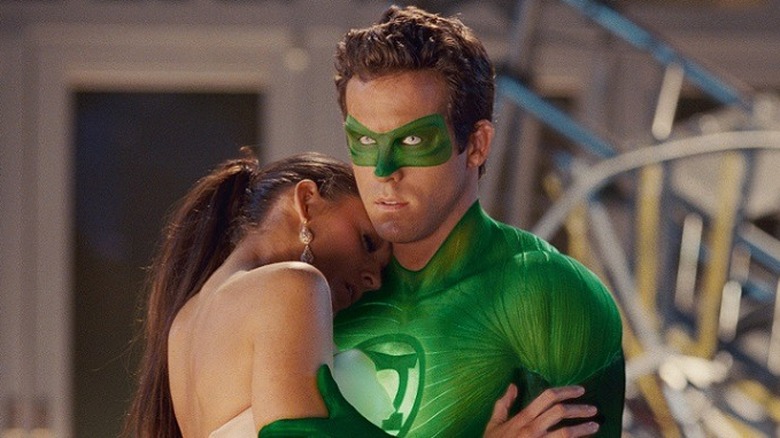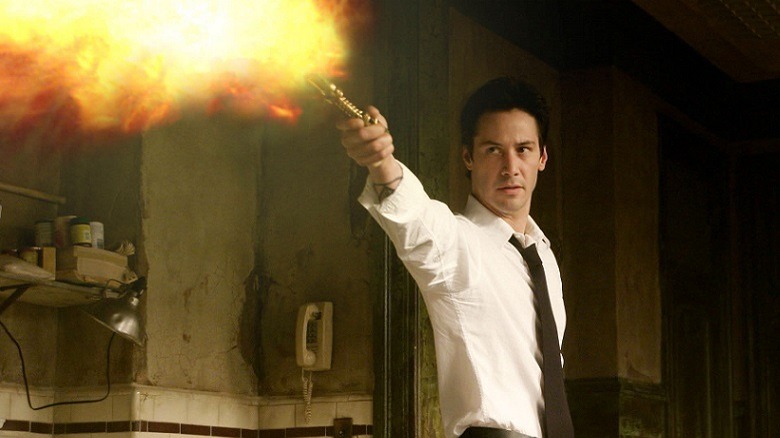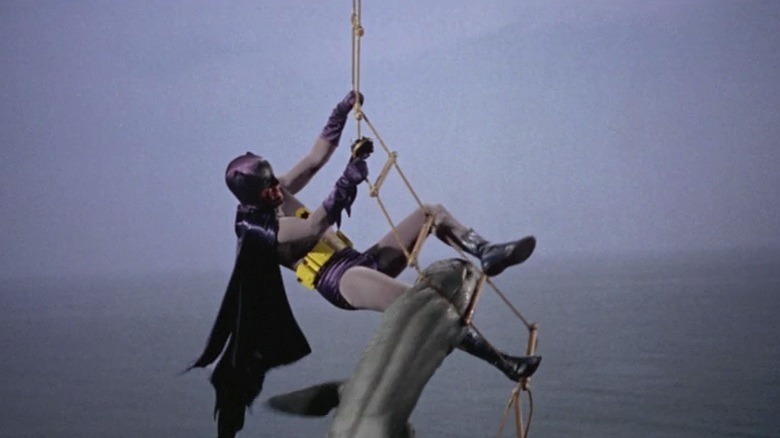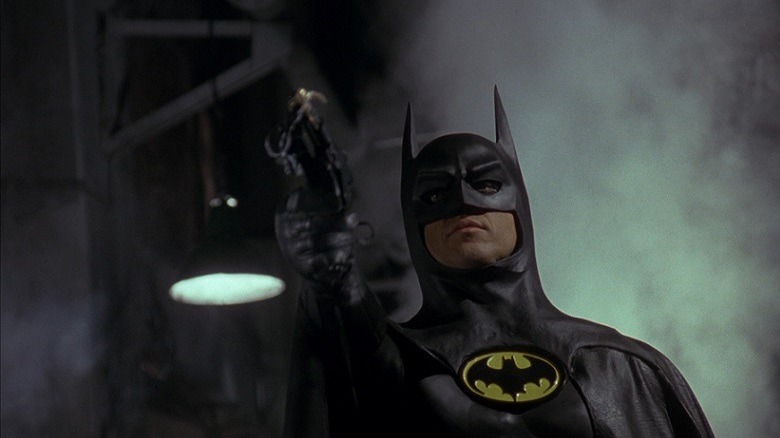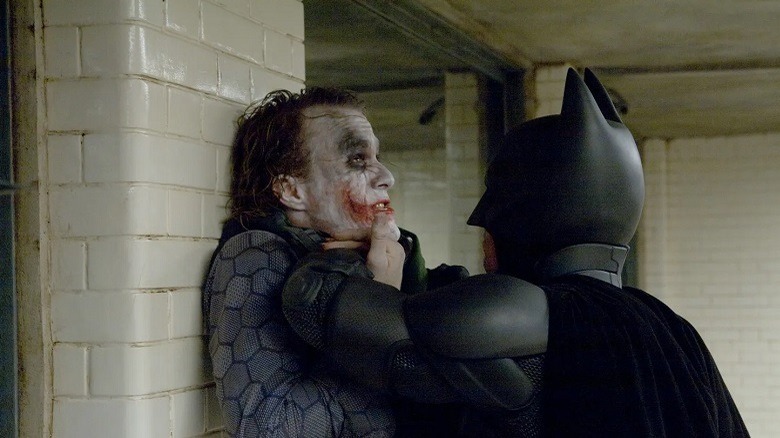Every DC Movie Made Prior To The DCEU Ranked From Worst To Best
With the creative success of "Birds of Prey" and "The ******* Squad" and films like "Black Adam," "Shazam! The Fury of the Gods," and the multiverse-spanning "The Flash" on the way, the DC Extended Universe has finally found its footing. The DCEU got off to a controversial start with 2013's "Man of Steel," but has since proved that it's as comfortable with comedy as it is with super-heroics.
However, it was Richard Donner's 1978 "Superman" that became the first DC film to meet with real success, and, despite little opportunities for crossovers, arguably set the stage for the success of today's live-action comic book adaptations. Plenty more followed. A few of the characters here may have once belonged to DC's other publishing imprints — DC's Vertigo line has inspired quite a few films — but now that they've all been incorporated into the standard DC Universe, I'm considering them fair game.
Also, despite an abundance of animated material, for reasons of brevity, we're only considering live action movies. So, with that in mind, up, up, and away!
22. Catwoman
It's to Halle Berry's eternal credit that she turned up in person to pick up her Golden Raspberry Award for worst actress for her purr-formance in "Catwoman," but, in an ideal world, this abhorrent excuse for a film shouldn't even exist. Rather than simply taking the more promising route and producing a spin-off for Michelle Pfeiffer's take on the feline felon, the filmmakers opted for a complete reboot that bears little resemblance to the character from the movies or the comics.
Berry plays a woman named Patience Phillips, and patience is exactly what you'll need to tolerate the lackluster script. Dealing with Catwoman's new muddled origin story and her attempts to halt the machinations of a crooked cosmetics company, the film seems little more than a confusing excuse to champion female empowerment whilst reducing the ordinarily excellent Berry to little more than a scantily-clad cipher. Thankfully, this Catwoman only had one short-lived life. What was she thinking?
21. Steel
In the comics, when Superman "died" at the bony claws of the Kryptonian genetic experiment known as Doomsday, a number of heroes rose up to take his place. One such man was John Henry Irons, an engineer who made himself an armored suit emblazoned with Superman's distinctive S-shield logo, sort of like a DC version of Iron Man, to honor the temporarily deceased Man of Steel.
As far as film legacies go, the movie version of "Steel" pounds Superman's flat with his trademark hammer. A hopelessly miscast Shaquille O'Neal plays the alloyed vigilante, parading around in a supposedly metal suit that's really made out of poorly painted rubber. Judd Nelson's pantomimic villain, Burke, elevates the material ever-so slightly, but the mediocre special effects, predictable plot, and unexpected levels of schmaltz make it feel more like a direct-to-TV feature than something intended for a cinema screen.
20. Superman IV: The Quest for Peace
Forget "Threads" and "The Day After." There's probably been no greater argument for nuclear disarmament than to rid the world of the risible Nuclear Man, the main foe in 1987's "Superman IV." With neatly coiffed hair and silver nails, this radioactive reprobate is laughable at best.
Created by Lex Luthor from a Superman clone imbued with nuclear waste, the filmmakers are clearly trying to recreate the superpowered conflict between Kal-El and Zod from the second film, but the film pales in comparison. It reeks of cheapness, with the Man of Tomorrow's true weakness revealed not as kryptonite, but budget cuts — "Superman IV" failed to recoup its meager $17 million budget at the domestic box office. When a U.K. town has to pretend to be Metropolis, you know that something's gone horribly wrong.
The tagline for the first Superman film may have been "You'll believe a man can fly." This time around, the shoestring budget (in many scenes, the filmmakers barely even attempt to hide the wires holding up Christopher Reeve) means that you're slightly less inclined to believe.
19. Batman & Robin
Without seismology equipment, it's difficult to determine the lowest point of Joel Schumacher's "Batman & Robin." Some might name the remarkable Bat-credit card scene, while others focus on his pecs and butt.
The truth, though? The rot began in Schumacher's previous film, "Batman Forever." And yet, even that neon-drenched migraine of a movie shines like a gleaming bat signal when compared to this dismal mess. At one point, Hollywood seemed to have a doomed theory that the more villains featured in a movie, the better the film would be. As proved here, it's a flawed hypothesis, only recently broken by "Spider-Man: No Way Home."
Uma Thurman fails to convince as Poison Ivy, and Arnold Schwarzenegger simply plays Mr. Freeze as Arnold Schwarzenegger in a glowing suit while spouting terrible ice-related puns. Ordinarily top-tier DC villain Bane is relegated to an ineffectual sidekick with some tubes sticking out of his back, and despite its title, the whole movie feels like a two-hour excuse to shoehorn Batgirl (Alicia Silverstone, completely devoid of charisma) into the franchise. And, Mr. Schumacher, there's no such place as Oxbridge University.
18. Supergirl
Kryptonite, that green crystalline substance that crops up with surprising frequency in the "Superman" universe, isn't the only weakness for your average Kryptonian. They're also vulnerable to magic. This is exploited to full effect in "Supergirl," which pits the Maid of Might against Faye Dunaway's witch, Selena. Sadly, little of the magic rubs off on screen.
Helen Slater is perfectly likeable as Kara Zor-El, Jor-El's niece. She's just given little to do in this obvious attempt to cash in her cousin's success. The true power of the most successful of the "Superman" movies is their utter sincerity, the ability of all involved to deliver an inherently silly concept with a straight face (and the wryest of winks). "Supergirl" is flawed because it's presented like a comedy, with laughable villains and a ludicrous plot — it feels like a parody of the material, so it's hard to find anything to admire in it. It's also an insult to cast actors of Faye Dunaway and Peter O'Toole's caliber, and then give them so little of substance to work with.
17. Jonah Hex
Luckily, Josh Brolin eventually got to appear in a half-decent superhero epic as Avengers big bad Thanos, but a decade earlier he played the lead role in this supernatural Wild West tale based on an obscure DC character.
Brolin is by far the best thing here, doing his best to make something decent out of the muddled plot, bizarre pacing, and the film's inability to trust the audience to remember something it was shown only moments earlier. Even the ordinarily reliable John Malkovich as the scenery-chewing villain Quentin Turnbull is disappointing here, while Megan Fox's Lilah feels like she was thrown in at the editing stage just to prove that there were actually women in the Wild West (even though, in Fox's own words, all of the female characters in the film are prostitutes).
"Johan Hex" is workmanlike and perfunctory, failing to bring anything new to the table, despite the potentially interesting crossover between the supernatural and the Old West. There's nothing in this mutilated mercenary's tale that would drive anybody to read any of the source material, which is a genuine shame.
16. The Return of Swamp Thing
Five years after British upstart Alan Moore revitalized the ailing "Swamp Thing" title by showing that comics could be about more than larger-than-life characters beating the stuffing out of each other, director Jim Wynorski's take on the compostable champion saw the Guardian of the Green doing just that. While the "Swamp Thing" comics were delving into complex issues such as existential dread and inter-species relationships, "The Return of Swamp Thing" was little more than an excuse for Swamp Thing to fight against bizarre monsters that resembled rejects from the island of Doctor Moreau.
This small-scale kaiju botanical battle royale is billed as a horror-comedy, but it definitely tends towards the latter, with very few scenes demonstrating any tension or drama. As a film about a man in a rubber suit fighting other men in rubber suits, it's perfectly adequate entertainment — it's just a bizarre choice of license, considering that the character's comics were busy reinventing the genre. Actress Heather Locklear does have one great (and vaguely smutty) gag about vegetarianism, but you can simply watch the trailer for that and save yourself some time.
15. Batman Forever
We should have noticed the cracks in "Batman Forever." The overuse of neon. The tendency to have characters shouting over each other, as opposed to engaging in dialogue. Michael Keaton had wisely departed at this stage, driven away by the script in which Two-Face teams up with disgruntled Wayne Enterprises employee Edward Nigma to invent a machine that'll suck the brains out of the citizens of Gotham City through their televisions. An audience member affected by Nigma's device might well go on to enjoy "Batman Forever."
Val Kilmer, the brand-new Batman and Bruce Wayne, does his best with the material he's given but it's hard to make an impression when you share screen time with Jim Carrey. Carrey's Riddler and Tommy Lee Jones' Two-Face squabble in almost every scene they're in, each considerable ego trying to make its presence known. "Batman Forever" also introduces Chris O'Donnell's Robin to the franchise, but even that seems like a labored excuse to sneak in a "Holy Rusted Metal" gag. "Batman Forever" is significantly better than the film that followed, but it's hard to find anything to enjoy in this noisy, garish mess.
14. Swamp Thing
Director Wes Craven would release "A Nightmare on Elm Street" to international fanfare some two years after "Swamp Thing," presumably relieved to excise the memories of a decidedly average comic book adaptation that bears little of his trademark style or wit, and that today feels like the odd one out on his distinctive oeuvre.
Loosely based on the comic book of the same name, Ray Wise plays Alec Holland, a scientist performing chemical research in the swamp. When rival Anton Arcane destroys his lab with explosives, Holland's corpse is thrown into the Louisiana bayou, but is resurrected through his bio-restorative formula and transformed into the human-vegetable hybrid known as Swamp Thing. Adrienne Barbeau (then John Carpenter's wife) plays love interest Alice Cable, sadly spending much of the movie relegated to a cleavage-wielding damsel in distress.
Durock does a respectable job of portraying the plant-based paragon, all portentously slow dialogue and anguished expressions. Louis Jordan is clearly having fun as the villain, yet it's a shame to see him reduced to another monster in a costume for the movie's climax. It's watchable, yet struggles to find an identity. It's torn between campness and horror, as much of a hybrid as Ol' Swampy himself.
13. Green Lantern
Not even safe from mockery by its own star, "Green Lantern" is a decidedly average movie elevated by the presence of Ryan Reynolds, who is effortlessly likeable as test pilot and soon-to-be superhero Hal Jordan. His charm and charisma carry this film much further than it deserves.
"Green Lantern" has proven to be a difficult property to adapt, languishing in development hell since 1997, with names like Kevin Smith and Quentin Tarantino failing to launch the property. It's easy to see why. "Green Lantern" is DC's take on space opera, focused on an intergalactic police force populated by countless alien species, not to mention a hero armed with a weapon restricted only by his imagination.
The highest praise that you can offer "Green Lantern" is that it's not as bad as you remember. Despite feeling like a prequel to a better, more interesting film, it zips along nicely, and the extensive special effects are surprisingly adequate. A lackluster villain isn't given enough depth or backstory, and the final act is a confusing huddle of CGI, but for all the jokes levelled at this movie over the years, Ryan's Green Lantern — and that CG-animated suit — isn't that bad.
12. Superman III
The first failure from both a commercial and critical perspective for Christopher Reeve's Superman series, "Superman III" sees the Last Son of Krypton face off against magnate Ross Webster, who seeks to make his fortune destroying by Colombia's coffee output. To help him, he enlists Richard Pryor's Gus, a computer programmer. Together, they create a new form of synthetic kryptonite.
The results are the most interesting thing about the film, as the kryptonite splits Superman into two distinct individuals. The concept of an evil Superman has been done to death (see "Invincible," "Brightburn" and DC's own "Injustice" comics), but it's fun to see Christopher Reeve play this anarchically dark take on the big blue boy scout. It's almost a letdown when the film ultimately comes down to a fight between Superman and an evil supercomputer, with some dodgy '80s video game-style graphics.
Never quite sure whether it's going for out-and-out comedy or not, "Superman III" is disjointed, almost as if it doesn't even belong in the same universe as the previous two films. There's no doubting Pryor's comedic chops — and his star was certainly on the rise in the early '80s — but he's a poor fit for Superman.
11. Constantine
Purists may have scoffed at the fundamental differences between "Constantine" and the comics, with John Constantine played by the considerably un-Liverpudlian and non-blonde Keanu Reeves, but the essence of "Hellblazer" remained remarkably intact despite the surface changes. Loosely based on Garth Ennis and Will Simpson's "Dangerous Habits" arc, "Constantine" sees our lead — a cynical, tortured, and terminally-ill magician — help a police officer investigate the mysterious of her sister, a line of inquiry that will reveal an apocalyptic plan for a war between Heaven and Hell. It's only through honorable deeds that John Constantine will be redeemed.
Welsh actor Matt Ryan would go on to play the Alan Moore-created character across a variety of media, who would eventually move from DC's adult Vertigo label to join the DC Universe proper, but Keanu's "Constantine" still stands as a fascinating and bold take on the character, treading some of the same territory as "Blade," "Hellboy," and "Spawn." With Reeves having a late-career renaissance thanks to "John Wick" and "The Matrix: Resurrections," it'll be interesting to see if he'll be tempted to don Constantine's trench coat again.
10. Batman Returns
Michael Keaton's Batman returns in this Tim Burton-helmed sequel, which introduces Danny DeVito's Penguin and Michelle Pfeiffer's Catwoman. It's far from a poor film, but it does feel like a failed attempt to once again bottle lightning. The elements are all there — the return of many members of the cast, the Gothic sensibilities, the incredibly distinctive set design (inspired by the work of production designer Anton Furst), and the sublime Danny Elfman soundtrack — but it ultimately falls short of the target.
The first movie had a wry sense of humor, but there's a bleak nihilism to the sequel that sacrifices much of the original's charm. Keaton, Pfeiffer, DeVito, and the ever-consistent Christopher Walken as the white-haired Max Schreck (a kind of spiritual successor to Walken's Bond villain, Maximillian Zorin) are as excellent as ever, but the fun we expect from the franchise is largely missing. The Dark Knight is, in this case, way too dark.
9. Batman (1966)
This is more like it. As camp as Christmas and more self-aware than ever, the 1966 movie adaptation of the successful "Batman" TV series sees Batman and the Boy Wonder confront their biggest and best villains in order to stop them from kidnapping the United World Organization's Security Council and taking over the world.
Adam West's performance as both Bruce Wayne and Batman was always pitch-perfect, delivered with an earnest sincerity that falls just short of winking at the audience. Burt Ward's Robin is all headstrong teenage enthusiasm. These central performances hold together what could have been an incredibly daft escapade.
The movie feels bigger than the TV series, taking the story from Gotham to the world stage. The set pieces are more ambitious, and it's hard not to love a film that introduces Bat-shark repellent and a scene in which Batman struggles to throw away a bomb, encountering nuns and innocent ducklings en route. Sadly, the movie barely broke even at the box office, but was far from a flop with either critics or and fans.
8. Superman Returns
I've always had a soft spot for Brandon Routh's take on the Man of Steel. No one will ever compare to Christopher Reeve, but Routh brought his own likeability and charm to the role. His Superman was convincing, and his Clark Kent suitably clumsy and awkward. He just deserved better than this slightly above-average movie.
Before Kevin Spacey was outed as an actual bad guy, "Superman Returns" saw him channeling Gene Hackman's Lex Luthor. Getting hold of Kryptonian technology from Superman's now-abandoned Fortress of Solitude, Luthor seeks to flood the planet as part of a real estate scheme. Seriously. Between this and "Superman III" wiping out Colombia's coffee production, one almost longs for the days when the bad guys just wanted to take over the world.
Short on action but big on heart, "Superman Returns" is a brave step forward for the Superman franchise, especially when it introduces Kal-El's child. Unfortunately, all that progress was ultimately brushed aside as we moved into the new grim-dark world of the DCEU.
7. Watchmen
Alan Moore and Dave Gibbons' seminal 12-part series "Watchmen" blew up the comics industry when it was released in 1986. An ambitious epic that effectively reinvented the superhero genre, "Watchmen" was prime fodder for a movie adaptation. And yet, many failed. As the Independent reports, directors like Terry Gilliam, Darren Aronofsky and Paul Greengrass were all attached at some stage, but it would take Zack Snyder, who had made his presence known with his excellent remake of "Dawn of the Dead" and his striking adaptation of Frank Miller's "300," to bring it to life.
Disowned by Moore, "Watchmen" covers complex themes like totalitarianism, patriotism, and identity, all hidden beneath a sprawling tale of the rise and fall of superheroes in a world on the brink of nuclear disaster. It's inclusion here is justified by Geoff John's modern comic book sequel, "Doomsday Clock," which brought this band of dysfunctional heroes into the DC Universe proper.
"Watchmen" is far from a perfect film — an ill-fitting intimacy scene would have been better left on the cutting room floor — but it's a visually striking movie that feels semi-faithful to the source material. Purists may argue that the new ending misses Moore's overall point, but the movie stands as an interesting attempt to film the unfilmable.
6. The Dark Knight Rises
Unlike any of the cinematic Batman series that came before it, Christopher Nolan's three-film run has a proper arc. It has a beginning, a middle, and, in "The Dark Knight Rises," a competent and definitive end. Nearly a decade after going into hiding as a result of the events of "The Dark Knight," Batman is forced out of self-imposed exile thanks to the machinations of the terrorist known as Bane.
Schumacher's "Batman and Robin" may have reduced Bane to a drug-dependent sidekick, but here Tom Hardy does justice to the popular Batman villain, a foe every bit Bruce's equal in both brawn and brain. The storyline, loosely based on the epic "Knightfall" saga, sees Bruce defeated and forced to rise again. It's the weakest film of the trilogy, but any series would have struggled to sustain that level of excellence. Ultimately, this is Nolan's story. It's removed from any other continuity, but it's also a memorable approach to the material that will influence films and comics for years to come.
(As an aside, I have a special fondness for this movie. During my trip to New York to witness the "Occupy Wall Street" movement, I stumbled into the filming of the climactic street scene — I may have been erased from cinematic history thanks to a green screen, but it's a lasting memory).
5. Superman
Richard Donner's "Superman" is a visual feast, with exemplary flying effects that caused cinema audiences of the time to gasp. "Superman" relates Clark Kent's familiar origin story, following him from his adolescence in Smallville through his early career in Metropolis. Many traditional elements from Superman's comics, including Lois Lane, Lex Luthor, Perry White, kryptonite, the Fortress of Solitude, and Jimmy Olsen, pop up along the way.
Unknown actor Christopher Reeve was cast as Superman, and he brings a genuine physical presence to the role. With subtle posture changes, he's as convincing as Clark as he is the Man of Steel, and it's hard to imagine now that anybody else was even considered for the part. "Superman" was one of the first of a new breed of fantasy movie, one that realized that, with proper casting and decent special effects, anything was possible.
4. Batman (1989)
In much the same way that doubters initially cast aspersions on Heath Ledger's casting as the Joker, Michael Keaton, an actor known best for "Mr. Mom," assorted sitcom work, and "Beetlejuice," faced an unbelievable amount of backlash when he was first fitted for Batman's cape and cowl.
But, just as with Ledger's performance, the release of "Batman" saw humble pie become a fixture of many critics' diets. Keaton was excellent as both Bruce Wayne and the Caped Crusader, expertly portraying the tortured and eccentric man behind the mask as well as his armored alter-ego. Three years prior, Frank Miller's outstanding "The Dark Knight Returns" reinvented the character for modern comic book readers, and Burton's movie did exactly the same thing for cinema-goers, eschewing the camp of the '60s in favor of a moody Gothic aesthetic. Gotham itself was now as much a character as any of its bizarrely clad denizens, while Danny Elfman's score rounded off a perfect package.
It's easy to forget the impact of Nicholson's Joker as well. With Batman's arch nemesis brought to life by a legendary actor, "Batman" is that rarest of superhero movies: one where the villain is at least as interesting as the hero.
3. Superman II
Even Gene Hackman's tongue-in-cheek portrayal of Lex Luthor is a formidable foe for the Man of Steel on a mental level, but it took a trio of Kryptonian supervillains from the Phantom Zone to put Superman through the physical wringer.
"Superman II" sees General Zod and his minions freed from the Kryptonian equivalent of a supermax, only to find themselves gifted with extraordinary powers courtesy of Earth's lower gravity and its yellow sun. Superman, now the unofficial custodian of Earth, must fight them to ensure the planet's survival, as Zod seeks to enslave humanity and Lex Luthor proves to be all too eager to betray his own species for personal gain.
Terence Stamp brings a wonderful arrogance to Zod, while his aides, the femme-fatale Ursa and mute Non, prove to be formidable lieutenants. As you'd expect, the sprawling fight scenes are wonderfully realized, and the Kryptonians make for excellent villains. One of the greatest strengths of this sequel is that it feels like a proper continuation of the 1978 original — it's more of the same, which is exactly what audiences at the time demanded.
2. Batman Begins
With the latest Batman reboot on the horizon, we're about to get yet another big-screen take on the Dark Knight — our third since 2005. As such, it can be difficult to appreciate exactly what Christopher Nolan accomplished with "Batman Begins." The comics of the '80s and '90s had seen the Caped Crusader take part in increasingly outlandish escapades, confronting New Gods and travelling across space and time. The dawning of the new millennium saw a return to basics, and the films would follow suit, with Nolan's film stripping out the camp that marked the Schumacher era and grounding the character in reality.
The gadgets were plausible, and the villains all too human. The fights were brutal and visceral, and took both a physical and emotional toll on our broken hero. For an origin story that we've witnessed countless times, it's telling that "Batman Begins" makes it interesting again, throwing in aspects that we'd never seen on film before. Christian Bale's Bruce isn't a million miles away from his Patrick Bateman; you could argue that they're equally as damaged, but land on different sides of the same coin. Nolan's distinct version of the character is still as watchable now as it was then, and "Batman Begins" remains one of the most interesting takes on the Bat and his earliest days.
1. The Dark Knight
The second part of Nolan's Dark Knight trilogy does what all good sequels should: It takes the premise of the first movie and elaborates and improves on it. Heath Ledger's Joker is the perfect nemesis for Bale's Batman. Both are equally as smart and calculating, but Ledger's Clown Prince of Crime casts the character as a force of chaotic nature, a cruel and sadistic genius who, even though he's physically defeated, reigns victorious at the movie's end.
Through his actions, the Joker disassembles everything that's dear to the Dark Knight, and it's a guilty pleasure to watch his plans unfurl. "The Dark Knight" is as smart a superhero film as you're likely to ever see, and every viewing reveals new layers. It still remains one of the greatest DC movies ever made, in or out of the DC Extended Universe. It's truly outstanding.
